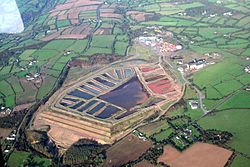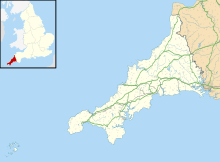Wheal Jane facts for kids

The Tailings Dam at Wheal Jane, from the air
|
|
| Location | |
|---|---|
| Location | Chacewater |
| County | Cornwall |
| Country | England |
| Coordinates | 50°14′31″N 5°07′35″W / 50.242°N 5.1264°W |
| Production | |
| Products | Tin, copper, lead, silver, zinc, pyrite, arsenopyrite, arsenic, ochre, iron ore |
| History | |
| Opened | Mid-18th century |
| Closed | 1992 |
Wheal Jane was an old tin mine located near the towns of Baldhu and Chacewater in West Cornwall, England. This area of Cornwall was once home to many mines.
Contents
A Look Back at Wheal Jane's History
Early Mining Days
People likely started mining for tin at Wheal Jane in the mid-1700s. Besides tin, miners also found other valuable metals. These included arsenic, copper, silver, and zinc. These different metals were found because of how the rocks formed near granite.
Around 1885, most mines nearby became too expensive to run. Wheal Jane managed to keep going for a few more years. This was mainly because it earned money from selling arsenic. However, it finally closed down around 1895.
Reopening and Challenges
Wheal Jane opened again in 1906. It was part of a bigger company called Falmouth Consolidated. They tried to make the mine more modern and cheaper to run. But it closed again within ten years.
Work started up slowly before World War II. At this time, people were more interested in new ways to get tin from old mine waste. So, the old piles of spoil (waste rock) were re-worked until 1946.
The Final Years
The mine reopened once more in 1969. A lot of work was done underground to improve the mine. The processing facilities on the surface were also made better. Eventually, a large company called Rio Tinto Zinc owned the mine.
Like other tin mines in Cornwall, Wheal Jane faced a big problem in 1985. The "International Tin Agreement" ended, and the price of tin around the world crashed. The mine never fully recovered after this. The pumps that kept water out of the mine were finally turned off in January 1992.
What Happened After the Mine Closed?
When the pumps were turned off, water began to fill the mine. This water picked up waste and washed over the exposed rocks. It became polluted and flowed into the surrounding ground.
In January 1992, this polluted water started to overflow. It was called "acid mine drainage." This water escaped into nearby rivers, like the Carnon River. It then flowed into Falmouth Bay. This pollution harmed fish and wild birds.
By 1994, steps were taken to fix the problem. Large settling ponds were built to treat the water. By 2002, treating the water had cost over £20 million.



